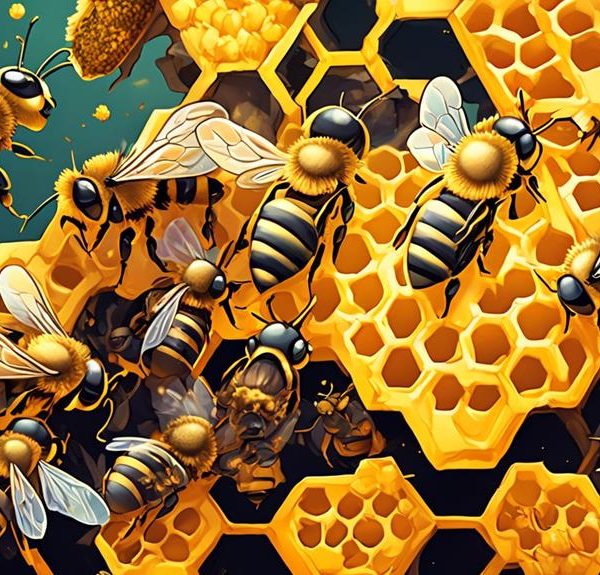Learn about the amazing resilience of bees and their surprising tactics to survive during rain, in 'What Bees Do When It Rains'.
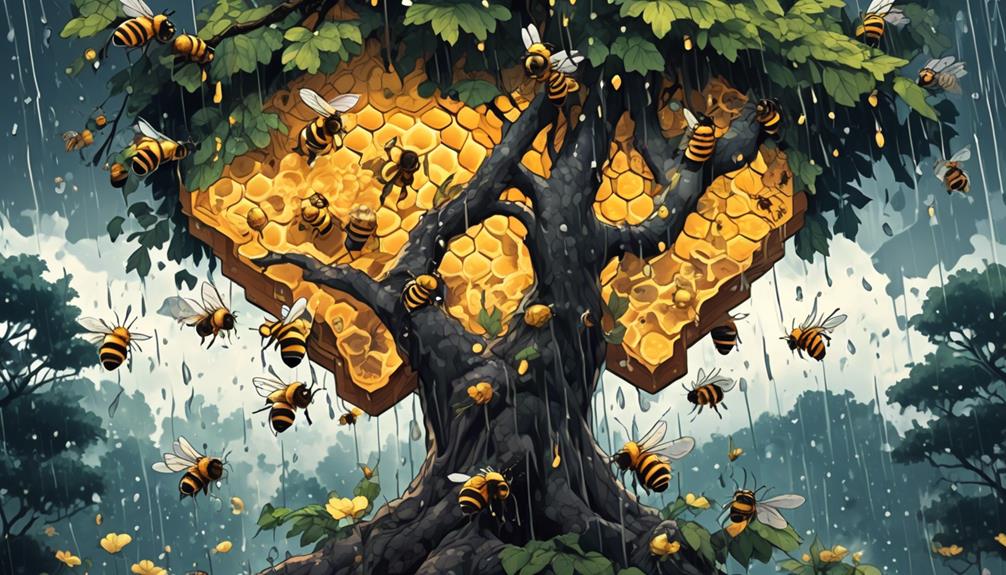
What Bees Do When It Rains?
Did you know that a bee's wings must beat about 200 times per second just to stay aloft? That's right, these industrious insects are truly marvels of nature's engineering.
But what happens when it rains? You've probably noticed that you don't see many bees buzzing about during a downpour. Rain, as it turns out, presents a significant challenge for bees.
But, how do they cope? Let's explore deeper into this fascinating subject, and you might find the resilience of these tiny creatures more astounding than you'd initially thought.
Key Takeaways
- Bees are not fans of venturing out in the rain due to the imbalance in mass between their small size and the weight of raindrops.
- Rain causes difficulty in collecting nectar and pollen, leading to food scarcity.
- Bees take refuge in their hives to protect their wings from damage and conserve energy during rain.
- Bees sense incoming weather changes and gather more nectar and pollen before rainstorms.
Understanding Bee Anatomy and Flight
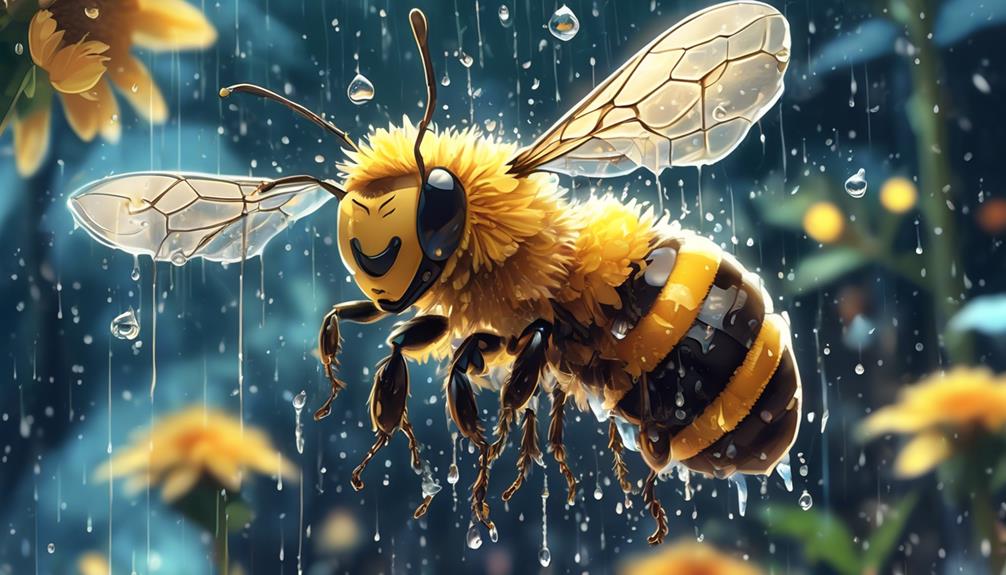
To comprehend how bees manage in the rain, you'll first need to grasp the intricacies of their anatomy and the nuances of their flight abilities. Bees are equipped with a streamlined body, built for efficiency and durability. A bee's body is covered in a layer of tiny hairs which trap air, providing insulation and buoyancy in wet weather. Their wings, delicate yet powerful, are sculpted to catch air currents and allow for agile maneuvers.
The bee's flight mechanism is a marvel of nature. They don't merely flap their wings; they rotate them, creating a vortex of air that propels them forward. This motion, combined with their lightweight bodies, enables them to navigate through raindrops with relative ease. It's like dodging bullets in slow motion for these tiny aviators.
However, rain poses a real challenge. Each raindrop is a potential knockdown for a bee. They must use their remarkable flight abilities to weave around these falling droplets. It's a risky game, and one that requires precision and finesse. To put it simply, when it rains, bees turn into expert rain dodgers.
The understanding of their anatomy and flight capabilities is the first key to unlocking this mystery.
Impact of Rain on Bee Activity
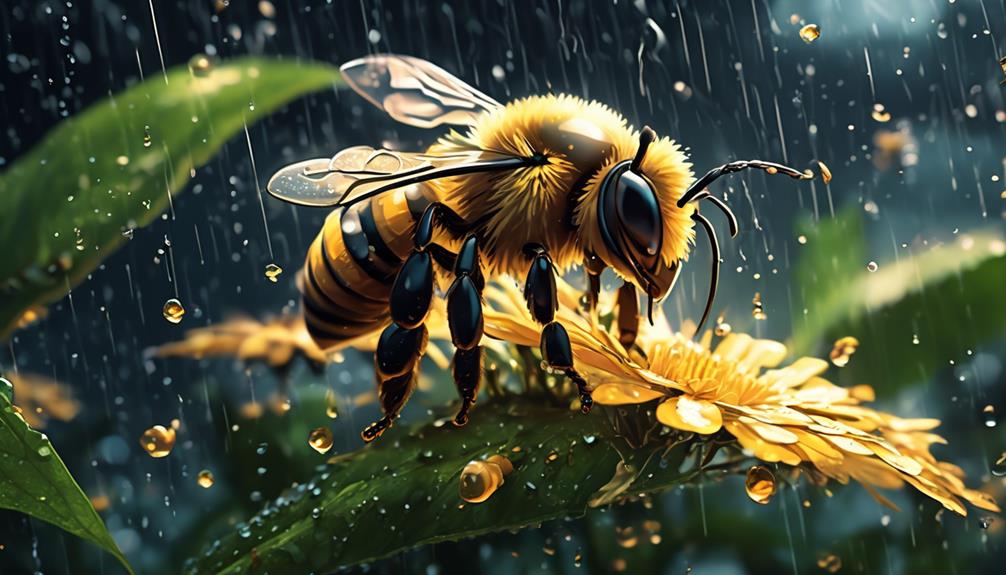
Despite their sophisticated flight skills, bees aren't fans of venturing out in the rain, and here's why. The tiny size of a bee relative to the weight of a raindrop means that even a slight drizzle can be a severe storm for them. This imbalance in mass can knock bees right out of the sky, causing them to drown or be injured.
Here's a more detailed look at how rain impacts bees:
Impact | Short Term Effects | Long Term Effects |
|---|---|---|
Physiological Stress | Difficulty in flying, increased energy consumption | Reduced lifespan, decreased population |
Food Scarcity | Difficulty in collecting nectar, pollen | Reduced honey production, weakened hive |
Hive Vulnerability | Increased risk of flooding, exposure to predators | Decreased hive productivity, potential hive abandonment |
Bee's Survival Tactics During Rain

Given the daunting obstacles rain presents to bees, they've developed some remarkable survival tactics to weather these challenging conditions. You'll often observe bees taking refuge in their hives when the rain begins to fall. This behavior isn't merely a retreat, but a strategic move to protect their wings from damage and conserve energy for necessary tasks.
In addition to staying put, bees rely heavily on their sense of vision for survival during rain. You see, bees have polarized vision, a unique adaptation that lets them detect patterns of sunlight in the sky, even through clouds. This ability allows them to navigate back to their hives in conditions that would otherwise leave them disoriented.
Moreover, bees exhibit a practice called 'shivering', a thermo-regulatory mechanism. By rapidly activating their flight muscles without flapping their wings, they can raise their body temperature and maintain their functionality despite the cold rain.
Lastly, when foraging bees are caught in unexpected downpours, they employ their stingers as makeshift anchors, buying time until they can escape the rain.
Rain and Bee Colonies: A Closer Look

Examining rain's impact on bee colonies reveals a layer of complexity in their survival strategies, as they don't merely hunker down and wait out the storm, but actively adapt their behaviors to ensure the colony's wellbeing. Bees exhibit an uncanny ability to sense incoming weather changes, and they'll hustle to gather more nectar and pollen before the storm hits. This ensures the hive has enough food reserves to sustain them through periods when they can't venture out.
Worker bees also play a critical role in maintaining the colony's temperature and humidity levels. When it rains, they'll adjust their wing vibrations to increase the hive's temperature, preventing hypothermia in the brood – the bee's version of an incubator.
Moreover, bees seal their hives with propolis, a bee-produced substance, creating a waterproof barrier against rainwater. This helps in keeping the hive dry and prevents the growth of harmful fungi and bacteria that thrive in damp environments.
Lastly, guard bees heighten their vigilance during rainstorms, ensuring no intruders exploit the situation.
Through these intricate adaptations, bees aren't just surviving the rains; they're thriving despite them, showing us a lesson in resilience, preparedness, and communal harmony.
How Weather Changes Affect Bees
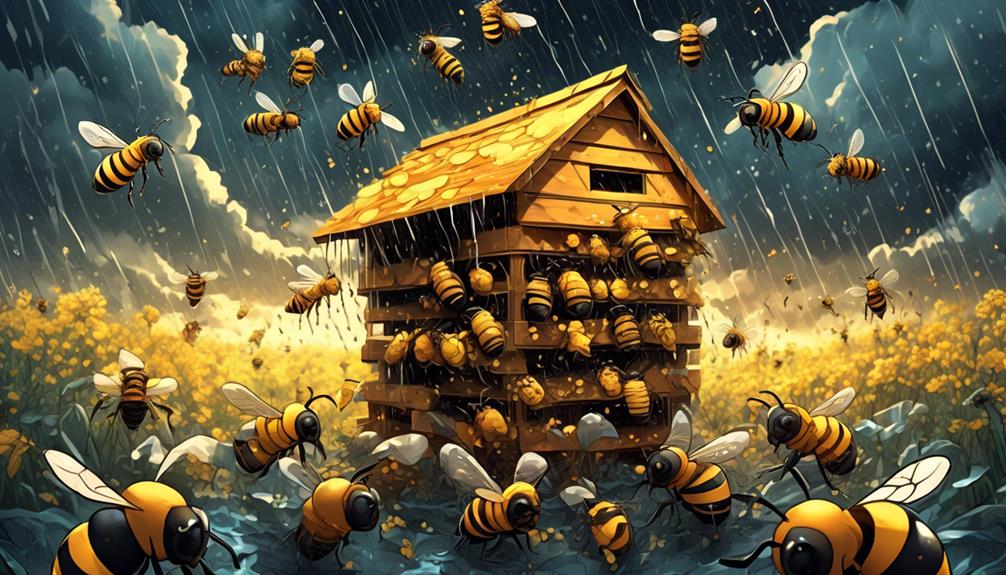
Just as you might alter your daily routine in response to the weather, bees also adjust their behavior significantly in response to changing weather conditions.
Cold weather, for instance, triggers a hibernation-like state in bees. They cluster together in the hive, forming a tightly-knit ball to conserve heat. They'll rotate from the center to the outside of the cluster, ensuring no bee freezes.
Rainy weather also impacts bees. They don't fly in the rain and will stay in the hive, using stored food sources. Rain can even disrupt their ability to communicate through 'waggle dances', a unique method bees use to share the location of food sources.
Similarly, windy conditions, fog, or heavy cloud cover can disorient bees, making it hard for them to navigate. They rely on the sun for direction, so they'll often stay put in unfavorable conditions.
Frequently Asked Questions
What Types of Flowers Do Bees Typically Seek Shelter in During Rain?
You're curious about where bees take shelter during the rain, particularly the types of flowers they favor.
Bees don't typically seek shelter in flowers when it rains. Instead, they return to their hives. However, they're known to hide under leaves and petals if they're caught out in the weather.
The type of flower isn't as important as the cover it provides. It's the bees' ability to stay dry and warm that's crucial.
How Does Heavy Rainfall Impact the Lifespan of a Bee?
Heavy rainfall can drastically shorten a bee's lifespan. Bees can't fly in the rain, and if they're caught in a downpour, they can become too wet to fly and may die of exposure. Persistent heavy rain can seriously impact a bee's lifespan, either through exposure or lack of food. Bees need to forage to survive, but if it's constantly raining, they can't gather food, leading to starvation.
How Does the Rain Affect the Bee's Ability to Produce Honey?
When it rains, bees can't fly to gather nectar, which directly affects their honey production. Heavy rain could damage the flowers they rely on for nectar, further reducing their food source. With less nectar, bees can't produce as much honey.
You'd also see a decrease in the population due to poor weather conditions, which consequently lowers honey production.
Do Different Species of Bees React Differently to Rainfall?
Yes, different species of bees do react differently to rainfall.
For instance, honeybees typically seek shelter in their hives during rain.
Bumblebees, however, are more resilient and can withstand colder, wetter conditions.
Some solitary bees might even use rain to their advantage, collecting water droplets for their nests.
How Does Continuous Rainfall Impact the Bee's Navigation and Communication Systems?
When continuous rain occurs, it can severely impact a bee's navigation and communication systems. You see, they use the sun as a compass, so heavy cloud cover disrupts their sense of direction.
It's also harder for them to emit and detect pheromones, crucial for communication. Furthermore, they can't fly well in rain, making it difficult to return to the hive or forage.
It's a significant obstacle to their survival and productivity.
Conclusion
So, you've learned how rain impacts bees and their colonies.
Bees, with their delicate wings and tiny bodies, aren't built for wet weather. They've developed survival tactics, like staying in their hives and reducing activity during rain.
Weather changes can significantly affect their behavior and survival. It's essential to understand these creatures' resilience, as their role in pollination is vital for our ecosystem.
Remember, every raindrop matters, especially when you're as small as a bee.

